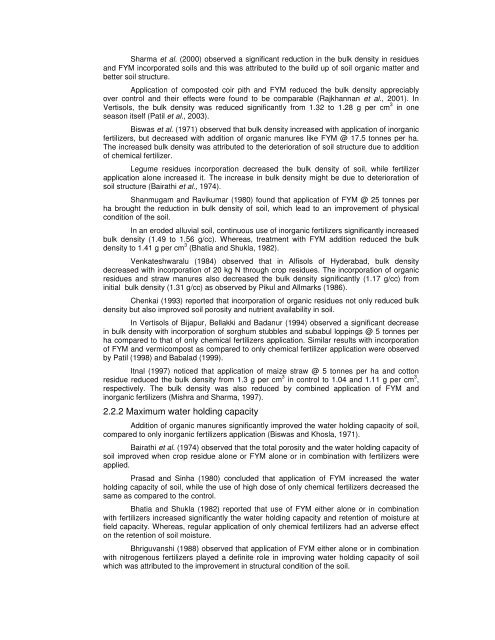impact of farmers' organic farming practices on soil properties in ...
impact of farmers' organic farming practices on soil properties in ...
impact of farmers' organic farming practices on soil properties in ...
Create successful ePaper yourself
Turn your PDF publications into a flip-book with our unique Google optimized e-Paper software.
Sharma et al. (2000) observed a significant reducti<strong>on</strong> <strong>in</strong> the bulk density <strong>in</strong> residues<br />
and FYM <strong>in</strong>corporated <strong>soil</strong>s and this was attributed to the build up <str<strong>on</strong>g>of</str<strong>on</strong>g> <strong>soil</strong> <str<strong>on</strong>g>organic</str<strong>on</strong>g> matter and<br />
better <strong>soil</strong> structure.<br />
Applicati<strong>on</strong> <str<strong>on</strong>g>of</str<strong>on</strong>g> composted coir pith and FYM reduced the bulk density appreciably<br />
over c<strong>on</strong>trol and their effects were found to be comparable (Rajkhannan et al., 2001). In<br />
Vertisols, the bulk density was reduced significantly from 1.32 to 1.28 g per cm 3 <strong>in</strong> <strong>on</strong>e<br />
seas<strong>on</strong> itself (Patil et al., 2003).<br />
Biswas et al. (1971) observed that bulk density <strong>in</strong>creased with applicati<strong>on</strong> <str<strong>on</strong>g>of</str<strong>on</strong>g> <strong>in</strong><str<strong>on</strong>g>organic</str<strong>on</strong>g><br />
fertilizers, but decreased with additi<strong>on</strong> <str<strong>on</strong>g>of</str<strong>on</strong>g> <str<strong>on</strong>g>organic</str<strong>on</strong>g> manures like FYM @ 17.5 t<strong>on</strong>nes per ha.<br />
The <strong>in</strong>creased bulk density was attributed to the deteriorati<strong>on</strong> <str<strong>on</strong>g>of</str<strong>on</strong>g> <strong>soil</strong> structure due to additi<strong>on</strong><br />
<str<strong>on</strong>g>of</str<strong>on</strong>g> chemical fertilizer.<br />
Legume residues <strong>in</strong>corporati<strong>on</strong> decreased the bulk density <str<strong>on</strong>g>of</str<strong>on</strong>g> <strong>soil</strong>, while fertilizer<br />
applicati<strong>on</strong> al<strong>on</strong>e <strong>in</strong>creased it. The <strong>in</strong>crease <strong>in</strong> bulk density might be due to deteriorati<strong>on</strong> <str<strong>on</strong>g>of</str<strong>on</strong>g><br />
<strong>soil</strong> structure (Bairathi et al., 1974).<br />
Shanmugam and Ravikumar (1980) found that applicati<strong>on</strong> <str<strong>on</strong>g>of</str<strong>on</strong>g> FYM @ 25 t<strong>on</strong>nes per<br />
ha brought the reducti<strong>on</strong> <strong>in</strong> bulk density <str<strong>on</strong>g>of</str<strong>on</strong>g> <strong>soil</strong>, which lead to an improvement <str<strong>on</strong>g>of</str<strong>on</strong>g> physical<br />
c<strong>on</strong>diti<strong>on</strong> <str<strong>on</strong>g>of</str<strong>on</strong>g> the <strong>soil</strong>.<br />
In an eroded alluvial <strong>soil</strong>, c<strong>on</strong>t<strong>in</strong>uous use <str<strong>on</strong>g>of</str<strong>on</strong>g> <strong>in</strong><str<strong>on</strong>g>organic</str<strong>on</strong>g> fertilizers significantly <strong>in</strong>creased<br />
bulk density (1.49 to 1.56 g/cc). Whereas, treatment with FYM additi<strong>on</strong> reduced the bulk<br />
density to 1.41 g per cm 3 (Bhatia and Shukla, 1982).<br />
Venkateshwaralu (1984) observed that <strong>in</strong> Alfisols <str<strong>on</strong>g>of</str<strong>on</strong>g> Hyderabad, bulk density<br />
decreased with <strong>in</strong>corporati<strong>on</strong> <str<strong>on</strong>g>of</str<strong>on</strong>g> 20 kg N through crop residues. The <strong>in</strong>corporati<strong>on</strong> <str<strong>on</strong>g>of</str<strong>on</strong>g> <str<strong>on</strong>g>organic</str<strong>on</strong>g><br />
residues and straw manures also decreased the bulk density significantly (1.17 g/cc) from<br />
<strong>in</strong>itial bulk density (1.31 g/cc) as observed by Pikul and Allmarks (1986).<br />
Chenkai (1993) reported that <strong>in</strong>corporati<strong>on</strong> <str<strong>on</strong>g>of</str<strong>on</strong>g> <str<strong>on</strong>g>organic</str<strong>on</strong>g> residues not <strong>on</strong>ly reduced bulk<br />
density but also improved <strong>soil</strong> porosity and nutrient availability <strong>in</strong> <strong>soil</strong>.<br />
In Vertisols <str<strong>on</strong>g>of</str<strong>on</strong>g> Bijapur, Bellakki and Badanur (1994) observed a significant decrease<br />
<strong>in</strong> bulk density with <strong>in</strong>corporati<strong>on</strong> <str<strong>on</strong>g>of</str<strong>on</strong>g> sorghum stubbles and subabul lopp<strong>in</strong>gs @ 5 t<strong>on</strong>nes per<br />
ha compared to that <str<strong>on</strong>g>of</str<strong>on</strong>g> <strong>on</strong>ly chemical fertilizers applicati<strong>on</strong>. Similar results with <strong>in</strong>corporati<strong>on</strong><br />
<str<strong>on</strong>g>of</str<strong>on</strong>g> FYM and vermicompost as compared to <strong>on</strong>ly chemical fertilizer applicati<strong>on</strong> were observed<br />
by Patil (1998) and Babalad (1999).<br />
Itnal (1997) noticed that applicati<strong>on</strong> <str<strong>on</strong>g>of</str<strong>on</strong>g> maize straw @ 5 t<strong>on</strong>nes per ha and cott<strong>on</strong><br />
residue reduced the bulk density from 1.3 g per cm 3 <strong>in</strong> c<strong>on</strong>trol to 1.04 and 1.11 g per cm 3 ,<br />
respectively. The bulk density was also reduced by comb<strong>in</strong>ed applicati<strong>on</strong> <str<strong>on</strong>g>of</str<strong>on</strong>g> FYM and<br />
<strong>in</strong><str<strong>on</strong>g>organic</str<strong>on</strong>g> fertilizers (Mishra and Sharma, 1997).<br />
2.2.2 Maximum water hold<strong>in</strong>g capacity<br />
Additi<strong>on</strong> <str<strong>on</strong>g>of</str<strong>on</strong>g> <str<strong>on</strong>g>organic</str<strong>on</strong>g> manures significantly improved the water hold<strong>in</strong>g capacity <str<strong>on</strong>g>of</str<strong>on</strong>g> <strong>soil</strong>,<br />
compared to <strong>on</strong>ly <strong>in</strong><str<strong>on</strong>g>organic</str<strong>on</strong>g> fertilizers applicati<strong>on</strong> (Biswas and Khosla, 1971).<br />
Bairathi et al. (1974) observed that the total porosity and the water hold<strong>in</strong>g capacity <str<strong>on</strong>g>of</str<strong>on</strong>g><br />
<strong>soil</strong> improved when crop residue al<strong>on</strong>e or FYM al<strong>on</strong>e or <strong>in</strong> comb<strong>in</strong>ati<strong>on</strong> with fertilizers were<br />
applied.<br />
Prasad and S<strong>in</strong>ha (1980) c<strong>on</strong>cluded that applicati<strong>on</strong> <str<strong>on</strong>g>of</str<strong>on</strong>g> FYM <strong>in</strong>creased the water<br />
hold<strong>in</strong>g capacity <str<strong>on</strong>g>of</str<strong>on</strong>g> <strong>soil</strong>, while the use <str<strong>on</strong>g>of</str<strong>on</strong>g> high dose <str<strong>on</strong>g>of</str<strong>on</strong>g> <strong>on</strong>ly chemical fertilizers decreased the<br />
same as compared to the c<strong>on</strong>trol.<br />
Bhatia and Shukla (1982) reported that use <str<strong>on</strong>g>of</str<strong>on</strong>g> FYM either al<strong>on</strong>e or <strong>in</strong> comb<strong>in</strong>ati<strong>on</strong><br />
with fertilizers <strong>in</strong>creased significantly the water hold<strong>in</strong>g capacity and retenti<strong>on</strong> <str<strong>on</strong>g>of</str<strong>on</strong>g> moisture at<br />
field capacity. Whereas, regular applicati<strong>on</strong> <str<strong>on</strong>g>of</str<strong>on</strong>g> <strong>on</strong>ly chemical fertilizers had an adverse effect<br />
<strong>on</strong> the retenti<strong>on</strong> <str<strong>on</strong>g>of</str<strong>on</strong>g> <strong>soil</strong> moisture.<br />
Bhriguvanshi (1988) observed that applicati<strong>on</strong> <str<strong>on</strong>g>of</str<strong>on</strong>g> FYM either al<strong>on</strong>e or <strong>in</strong> comb<strong>in</strong>ati<strong>on</strong><br />
with nitrogenous fertilizers played a def<strong>in</strong>ite role <strong>in</strong> improv<strong>in</strong>g water hold<strong>in</strong>g capacity <str<strong>on</strong>g>of</str<strong>on</strong>g> <strong>soil</strong><br />
which was attributed to the improvement <strong>in</strong> structural c<strong>on</strong>diti<strong>on</strong> <str<strong>on</strong>g>of</str<strong>on</strong>g> the <strong>soil</strong>.

















